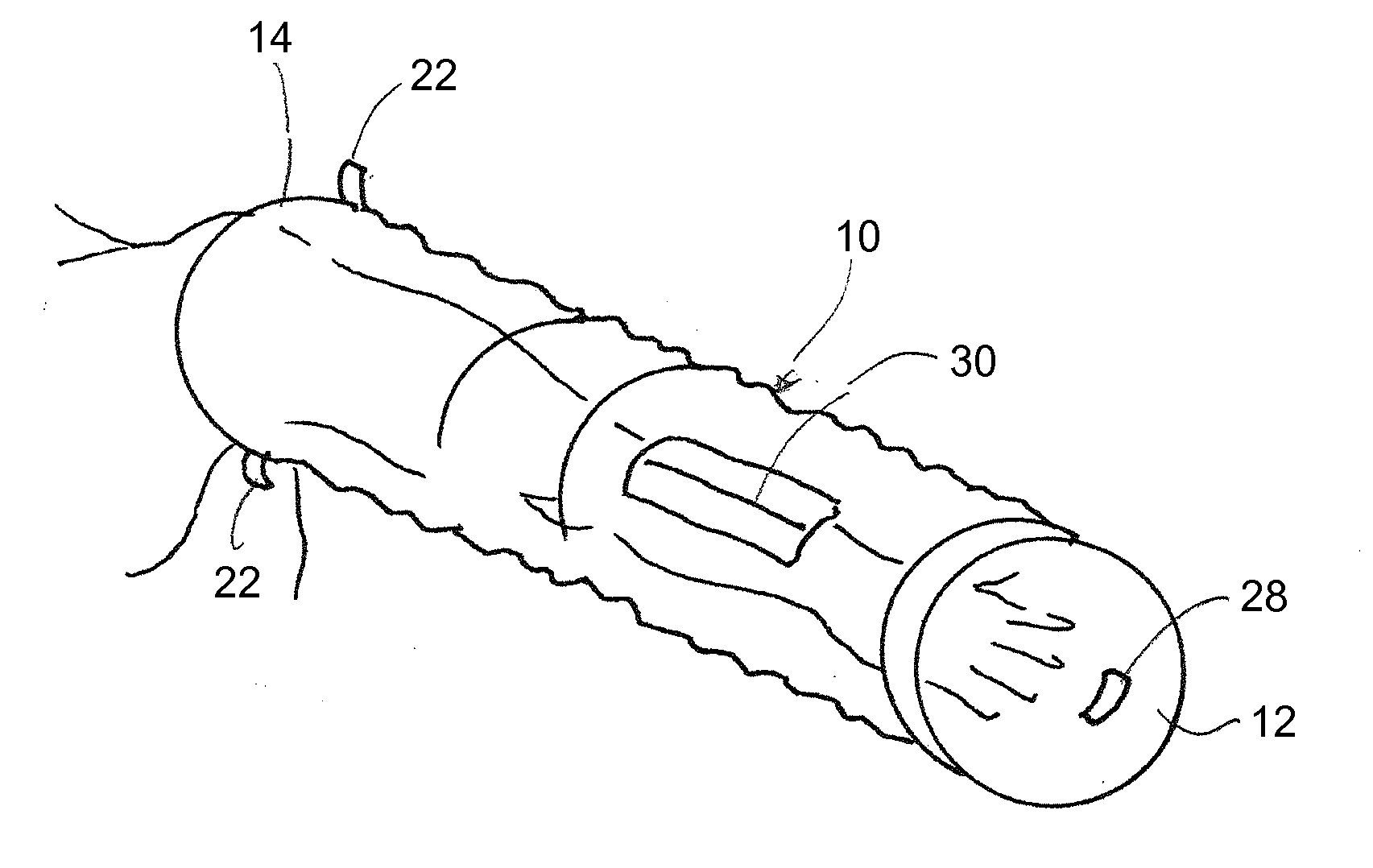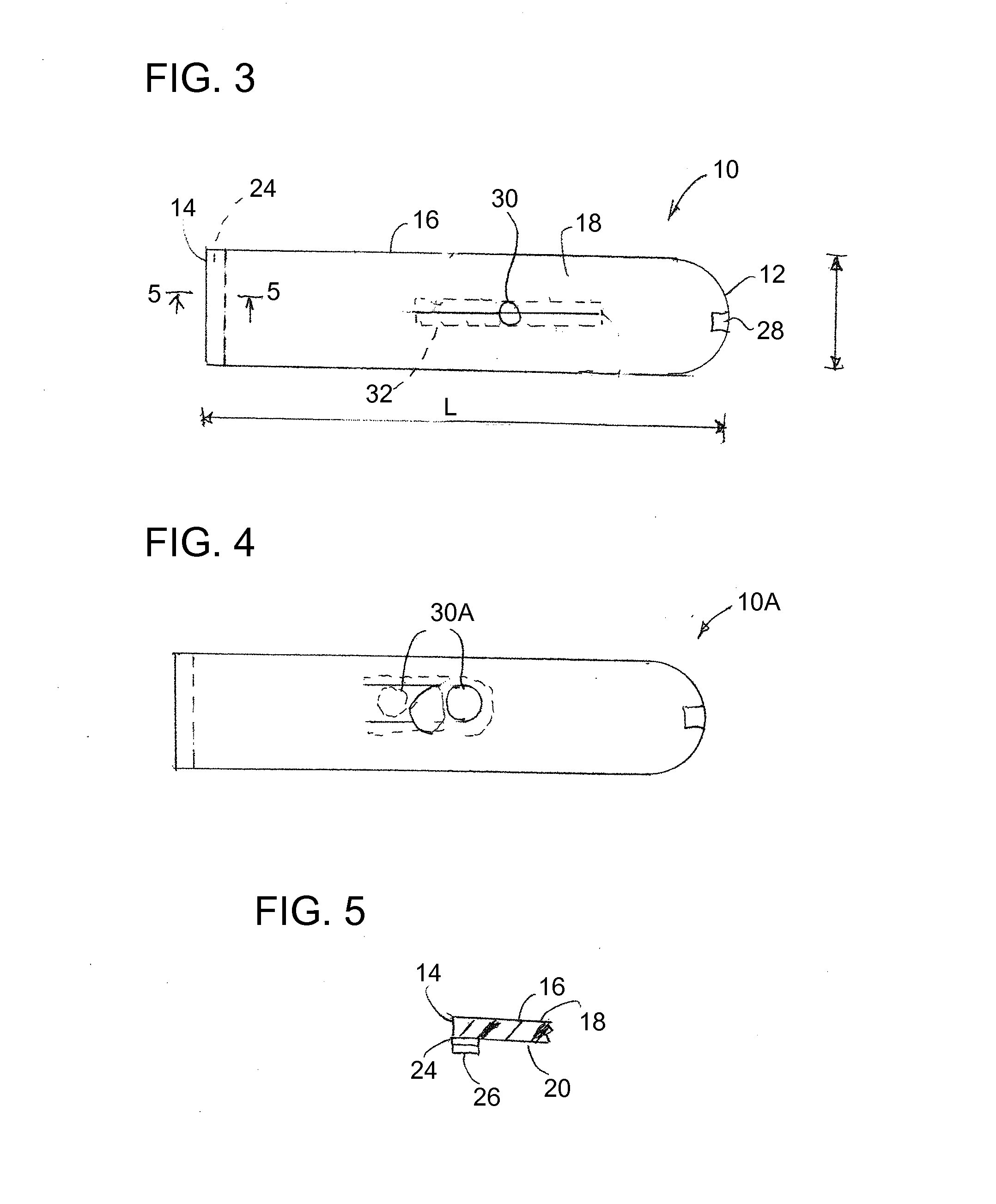Disposable radial access catheterization sleeve
- Summary
- Abstract
- Description
- Claims
- Application Information
AI Technical Summary
Benefits of technology
Problems solved by technology
Method used
Image
Examples
second embodiment
[0047]A radial access catheterization sleeve in accordance with the invention is identified generally by the numeral 110 in FIGS. 8-10. The sleeve 110 differs from the sleeve 10 described and illustrated above primarily with respect to the initial configuration prior to mounting on the patient and the method of mounting onto the patient. However, the sleeve 110 has a shape similar to the sleeve 10 after mounting on the patient and has all of the above-described advantages. More particularly, the sleeve 110 initially is a substantially rectangular sheet 112 with opposite first and second side edges 114 and 116, a proximal edge 118 and a distal edge 120. The sheet 112 has a length of approximately 90 cm. A strip of adhesive 122 extends adjacent the first side edge 14 and is covered by a removable release liner 124. An extension 126 extends from the proximal edge 118 beginning at a position approximately 25 cm. from the adhesive strip 122 and continuing for a distance of approximately ...
third embodiment
[0050]the invention is identified generally by the reference numeral 210 in FIGS. 12-14. The sleeve 210 is similar to the sleeve 110 described and illustrated above. However, the sleeve 210 does not have a preformed mitten. More particularly, the sleeve 210 is formed from a generally rectangular sheet 212 having opposite first and second side edges 214 and 216, a proximal edge 218 and a distal edge 220. First and second longitudinally extending fold lines 222 and 224 extend substantially parallel to the first and second side edges 214 and 216. The first fold line 222 is spaced from the first side edge 214 by approximately 60 cm. and a bottom panel 226 is defined between the first side edge 214 and the first fold line 222. The first and second fold lines 222 and 224 are spaced from one another by approximately 60 cm and define a top panel 228 therebetween. A small surgical drape panel 230 extends from the second fold line 224 to the second side edge 216. An access opening 230 is form...
fourth embodiment
[0052]A sleeve in accordance with the invention is identified generally by the reference numeral 310 in FIG. 15. The sleeve 310 includes a rectangular sheet 312 having first and second side edges 314 and 316, a proximal edge 318 and a distal edge 320. A fold line 322 extends the length of the sheet 312 from the proximal edge 318 to the distal edge 320 and is aligned substantially parallel to the side edges 314 and 316. Thus, a bottom panel 324 is defined between the first side edge 314 and the fold line 322, and a top panel 326 is defined between the fold line 322 and the second side edge 316. An adhesive strip 328 covered by a release liner 330 extends substantially along the second side edge 316. Additionally, a distal adhesive strip 332 covered by a release liner 334 extends along portions of the distal edge 320 aligned with the top panel 326. An access opening 336 is formed in the top panel 326 approximately centrally between the fold area 322 and the second side edge 316. The a...
PUM
 Login to View More
Login to View More Abstract
Description
Claims
Application Information
 Login to View More
Login to View More - R&D
- Intellectual Property
- Life Sciences
- Materials
- Tech Scout
- Unparalleled Data Quality
- Higher Quality Content
- 60% Fewer Hallucinations
Browse by: Latest US Patents, China's latest patents, Technical Efficacy Thesaurus, Application Domain, Technology Topic, Popular Technical Reports.
© 2025 PatSnap. All rights reserved.Legal|Privacy policy|Modern Slavery Act Transparency Statement|Sitemap|About US| Contact US: help@patsnap.com



